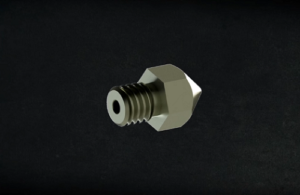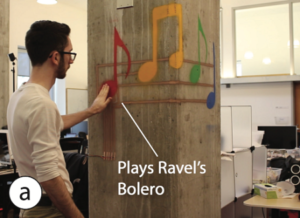In today’s 3D Printing News Briefs, we start with some announcements from AMPOWER, including its new cost calculator for metal 3D printed parts. Moving on, a German startup will soon launch a Kickstarter campaign for a new tungsten 3D printing nozzle. Finally, researchers at MIT CSAIL have developed a new system for using conductive inks to create large interactive surfaces with sensors and displays.
AMPOWER Releases New Part Cost Calculator
 Metal AM consulting firm AMPOWER released a few announcements this week, starting with its new cost calculator for 3D printed parts. This new tool provides an estimate of the minimum and maximum cost for seven different metal AM technologies and four material groups, so that customers can quickly assess how much a 3D printed part will cost them. The calculator, available on the AMPOWER Report homepage, is available to test for free until the end of April, after which time only subscribers will be able to access it.
Metal AM consulting firm AMPOWER released a few announcements this week, starting with its new cost calculator for 3D printed parts. This new tool provides an estimate of the minimum and maximum cost for seven different metal AM technologies and four material groups, so that customers can quickly assess how much a 3D printed part will cost them. The calculator, available on the AMPOWER Report homepage, is available to test for free until the end of April, after which time only subscribers will be able to access it.
The German company has also put its first E-learning session online – a free, 20 minute course about the quality of metal in AM that focuses on qualification and provides a look at best practices. Finally, the new AMPOWER Report 2020 will soon be released, and if you pre-order a copy now, using code PREORDER2020, you’ll receive a 10% discount on the Advanced Report. This offer is valid until April 30, 2020.
3DHex Kickstarter Campaign for Tungsten 3D Printer Nozzle
 German startup 3DHex was founded to solve some of the current problems in the 3D printing industry, starting with a tungsten 3D printer nozzle for high-temperature, abrasive printing. The Tungzzle, soon to be launched on Kickstarter, has a full metal housing and is made of an alloy with 95% pure tungsten content. This material is extremely hard and dense, with high thermal conductivity, excellent wear resistance, and the highest melting point of all refractory metals. It’s a good choice to use for a 3D printing nozzle, as it enables printing with highly abrasive materials without damaging the nozzle’s interior, and its excellent temperature resistance means you can print with high-temperature materials like nylon and PEEK.
German startup 3DHex was founded to solve some of the current problems in the 3D printing industry, starting with a tungsten 3D printer nozzle for high-temperature, abrasive printing. The Tungzzle, soon to be launched on Kickstarter, has a full metal housing and is made of an alloy with 95% pure tungsten content. This material is extremely hard and dense, with high thermal conductivity, excellent wear resistance, and the highest melting point of all refractory metals. It’s a good choice to use for a 3D printing nozzle, as it enables printing with highly abrasive materials without damaging the nozzle’s interior, and its excellent temperature resistance means you can print with high-temperature materials like nylon and PEEK.
“At this moment, you have to pay high prices for individual task-specific nozzles, which often correspond to or exceed the price of the product for which they were purchased – a low-cost 3D printer,” 3DHex founders Christopher and Paul told 3DPrint.com.
“Our goal is to use our tungsten nozzle to set a new affordable standard for desktop 3D printing by combining all the key benefits in one product, increasing the possibilities of average 3D home printers and creating the ultimate balance between performance and price.”
MIT CSAIL’s New Project

Figure 15. Ambient Music Interface on a concrete pillar with a porous surface: (a) Start song by touching a note.
We always enjoy hearing about the many innovative projects that come out of MIT’s Computer Science and Artificial Intelligence Laboratory, better known as CSAIL. The latest is SprayableTech, a system that allows users to create large-scale interactive surfaces with sensors and displays with the help of conductive inks. The system uses printed stencils, a 3D editor, and air-brushable inks in order to enable different displays – for instance, interactive sofas that can control your TV with embedded sensors. A paper about this fascinating project, titled “Sprayable User Interfaces: Prototyping Large-Scale Interactive Surfaces with Sensors and Displays,” was just published.
The research team states in the abstract, “We present Sprayable User Interfaces: room-sized interactive surfaces that contain sensor and display elements created by airbrushing functional inks. Since airbrushing is inherently mobile, designers can create large-scale user interfaces on complex 3D geometries where existing stationary fabrication methods fail.
“To enable Sprayable User Interfaces, we developed a novel design and fabrication pipeline that takes a desired user interface layout as input and automatically generates stencils for airbrushing the layout onto a physical surface. After fabricating stencils from cardboard or projecting stencils digitally, designers spray each layer with an airbrush, attach a microcontroller to the user interface, and the interface is ready to be used.
“Our technical evaluation shows that Sprayable User Inter-faces work on various geometries and surface materials, such as porous stone and rough wood. We demonstrate our system with several application examples including interac-tive smart home applications on a wall and a soft leather sofa, an interactive smart city application, and interactive architecture in public office spaces.”
The main contributions the team made with this research are a toolkit that supports makers when prototyping large-scale interactive surfaces; a new fabrication process for making these surfaces with sensor and display elements; a user study on precision of sprayed conductive traces with projected stencils; and an evaluation of how conductive sprayed copper traces are on different geometries and surface areas. This project has a major real-life application for smart homes – you can flip through a digital photo album by waving your hand across the arm of your sofa, or turn on the light by pressing a certain spot on the wall! To learn more, you can check out their paper here, or watch the video below.
Discuss these stories and other 3D printing topics at 3DPrintBoard.com or share your thoughts in the Facebook comments below.
Subscribe to Our Email Newsletter
Stay up-to-date on all the latest news from the 3D printing industry and receive information and offers from third party vendors.
Print Services
Upload your 3D Models and get them printed quickly and efficiently.
You May Also Like
3D Printing News Briefs, June 11, 2025: Sustainability, Automotive Tooling, & More
We’re starting with sustainability news in today’s 3D Printing News Briefs, as EOS has strengthened its commitment on climate responsibility, and Zestep is making 3D printing filament out of eyewear...
3D Printing 50 Polymer Stand-In Parts for Tokamaks at the PPPL & Elytt Energy
Of all the world’s things, a tokamak is one of the hardest, most complex, expensive and exacting ones to make. These fusion energy devices make plasma, and use magnets to...
3D Printing News Briefs, May 17, 2025: Color-Changing Materials, Humanoid Robot, & More
We’re covering research innovations in today’s 3D Printing News Briefs! First, Penn Engineering developed 3D printed materials that change color under stress, and UC Berkeley researchers created an open source,...
Firehawk Aerospace Partners with JuggerBot 3D, Gets $1.25M from AFWERX for 3D Printed Propellants
Texas-based Firehawk Aerospace, an advanced energetic materials firm that works with aerospace and defense applications, announced a strategic partnership with JuggerBot 3D, an Ohio-based large-format 3D printer manufacturer. Together, the...

































